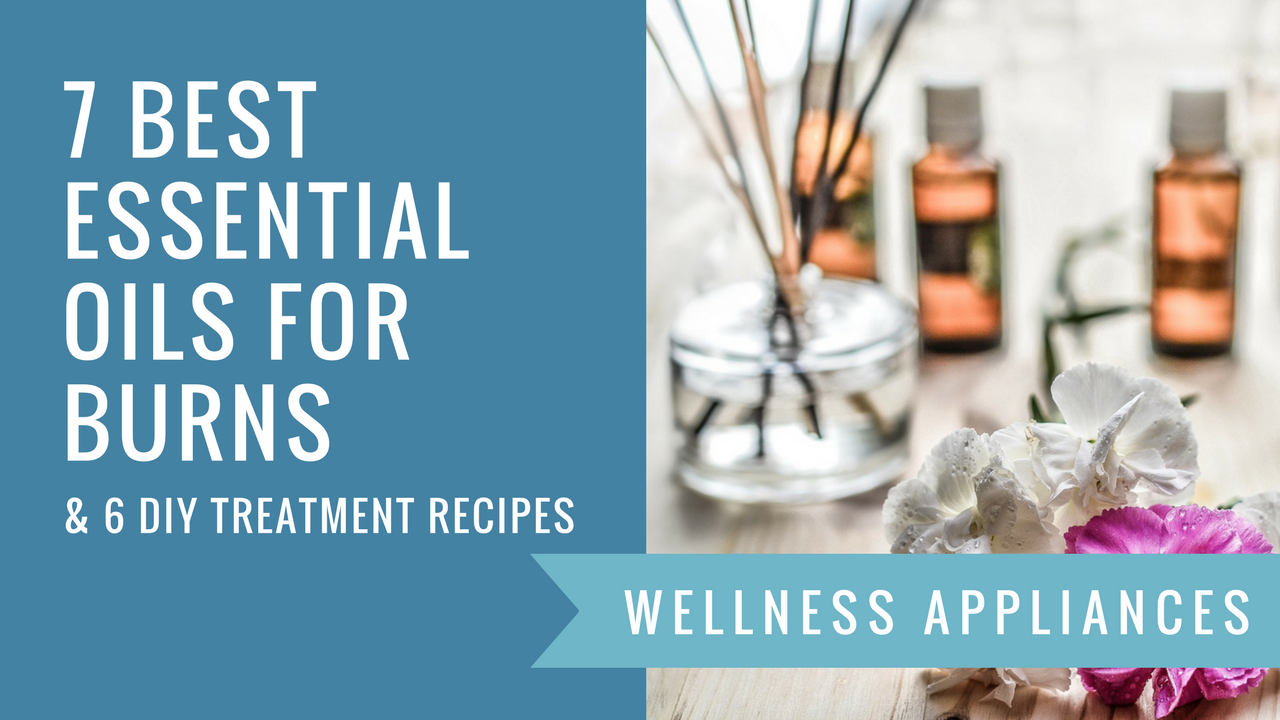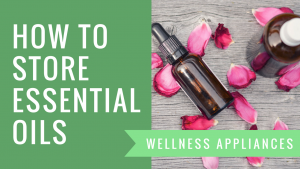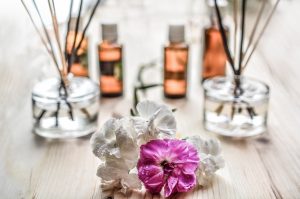Have you ever accidentally burnt yourself while cooking or when ironing your clothes? The answer is probably affirmative. We all share this unpleasant and quite painful experience. Human skin can be extremely sensitive to the heat. Even an innocent day out in the sun can cause extreme damage to the epidermis, the outer layer of the skin. Yes, sunburns are the most common type of the first-degree burn!
We can all agree that burns are extremely uncomfortable. They cause stinging pain and extreme sensitivity until the skin complete heals and rejuvenates. When experiencing these symptoms, people often turn to over-the-counter ointments or even painkillers, neglecting natural solutions altogether.
Essential oils enriched with antibacterial and anti-inflammatory properties have been used to treat burns and wounds for centuries. It was not until these recent years that essential oils and their unique chemical structure sparked interest amongst scientists. Each year new medical studies prove the common knowledge of our ancestors.
Essential oils speed up the healing process of damaged skin and prevent infections and scaring. Bellow listed essential oil and natural remedies will help your skin recover quickly without any side effects.
Types of Burns
Before we dive into the essential oils, we first have to recognize the difference between types of burns. Burns are medically defined as damaged skin tissue caused by exposure to heat, steam, electricity, chemicals, sun etc.
Burns are according to their severity categorized into these three major groups:
1. First-degree burns:
First-degree burns affect only the outer layer of the skin. Typical symptoms include pain, redness, and sometimes mild swelling. When healing, affected skin typically dries and peels away. First degree burns are most commonly caused by steam, hot liquids and exposure to the sun. They heal pretty quickly and are therefore not considered dangerous.
2. Second-degree burns:
Second-degree burns affect outer and middle layer of the skin. Often called partial thickness burns, they cause pain, redness, swelling and blistering. They take longer to heal and are considered more dangerous than first degree burns. Severe sunburns characterized by blistering fall into this category.
3. Third-degree burns:
Third-degree burns affect outer, middle and deep layers of the skin. They often damage underlying fat and muscle tissue as well. These burns are often called full thickness burns. Symptoms include white and black burnt skin. Such burns require immediate medical attention.
Patients most commonly undergo antibiotic treatment or even skin grafting. Patients with third-degree burns are highly susceptible to infections and other complications.
Note: If you have third-degree burns or large burns seek immediate medical attention!
7 Best Essential Oils for Burns
Essential oils capture the healing essence of most valuable plants of the Erath. Enriched with highly influential molecules, they are able to promote blood circulation, alleviate pain, soothe skin and suppress inflammation. In other words, they nourish and protect skin.
These following essential oils have according to the common knowledge and medical studies shown best potential in the treatment of burns.
1. Lavender Essential Oil
Lavender essential oil is arguably one of the most recognizable and common essential oils on the market today. You can find this exceptional natural remedy in just about every household. Mostly known for its calming scent, lavender essential oil holds many more positive properties.
Lavender essential oil is an excellent natural antiseptic and analgesic agent. Its antiseptic qualities will protect your exposed skin tissue from bacterial infection while its analgesic side will relieve you from stinging pain and discomfort. Additional anti-inflammatory components found in the formula can suppress redness and swelling of the affected area.
Overall calming and soothing nature of the oil helps relieve body and mind from stress. People affected by burns are often traumatized. Lavender essential oil positively affects our mood, anxiety, and sleep.
Fun fact: René-Maurice Gattefossé, a well known French chemist who invented the word aromatherapy, discovered healing properties of lavender essential oil in quite an unconventional way. One day, while working in his lab, René burnt himself badly.
In the midst of panic, he submerged his hand in the nearest liquid, which happened to be lavender essential oil. To his surprise, he discovered a hidden treasure. Quick and nearly painless healing inspired him to investigate the effect of lavender essential oil on burns.
Rating: 4.3/5
2. Tea Tree Essential Oil
Tea tree essential oil, also known as melaleuca essential oil, is derived from twigs and leaves of Melaleuca alternifolia tree native to Australia. The process of distillation makes sure all powerful antibacterial, antiviral and antimicrobial qualities are captured in every single drop of the oil. These properties protect burned and exposed skin from harmful microorganisms and free radicals that often slow down the regeneration process.
Additionally, tea tree essential oil improves the appearance of scars and blemishes on the skin. Its antioxidant properties will help your skin heal as smoothly as possible, without prominent scarring. The stimulating nature of the oil also improves blood circulation in the affected area. Reliable oxygen supply to your burns will enable quick and correct cellular growth.
Rating: 4.5/5
3. Geranium Essential Oil
Geranium essential oil is an excellent natural remedy for treating burns and sunburns. Its potential can be attributed to powerful antibacterial and antimicrobial qualities. They successfully protect exposed skin tissue against bacteria known to cause serious infections.
2004 study published in Journal for the International Society for Burn Injuries examined the effects of different essential oils on third-degree burns. Researchers found that tested geranium essential oil and gapeseed oil blend successfully combated MRSA infection caused by so-called staph bacteria. This is a revolutionary finding because staph bacterium is known to be resistant to many different antibiotics used in medicine today.
Note: Geranium and tea tree essential oil blend was most effective in fighting against S. aureus. bacterium!
Geranium essential oil is also cytophylacitic in nature, meaning it protects skin cells against membrane deformity and breakdown. To make this more understandable, geranium oil promotes the healthy replacement of dead skin cells with new ones. Any simple geranium oil remedy will help your burnt skin peel away without risks.
Source: https://www.ncbi.nlm.nih.gov/pubmed/15555788
Rating: 4.4/5
4. Frankincense Essential Oil
Frankincense essential oil is derived from the resin of Olibanum trees native to Arabian Peninsula and Africa. Frankincense oil is mostly known for its sedative qualities that come in handy when treating anxiety, stress, and depression. Frankincense aromatherapy helps restore mental health in people with severe burns.
Sometimes the events leading to such skin injuries are much more harmful to the body than actual burns. We have to remember that taking care of our mental health is just as important as taking care of our physical health. So, slow down, relax and fix yourself a frankincense aromatherapy in your room.
Frankincense essential oil can be used in many different ways. With topical application, you can take full advantage of the antiseptic properties found in oil. These will help you prevent infections. Without any harmful microorganism thriving on your wound, your skin will heal back to its original state in a matter of no time.
Rating: 4.4/5
5. Peppermint Essential Oil
Peppermint essential oil is well known for its cooling ability that comes in handy when treating red, inflamed blistered burns. The cooling sensation generated by the active component called menthol can easily soothe exposed and sensitive inner layers of the skin as well as disturbed nerve endings. Topical application of this refrigerant will help you suppress throbbing pain and swelling.
In addition to menthol, peppermint essential oil contains other essential minerals and vitamins known to promote our health and immunity. Presence of calcium is especially appreciated. It is believed that this exact mineral gives peppermint essential oil its painkilling attributes.
People affected by sunburns often experience a headache after spending too much time in the sun. Peppermint essential oil will let you kill two birds with one stone. Inhalation of peppermint oil vapor will help you relieve your headache or a migraine.
Note: Peppermint essential oil is very strong. Dilute it with carrier oil before topical application!
Rating: 4.7/5
6. Roman Chamomile Essential Oil
We all know that chamomile tea calms and soothes the body. Properties of chamomile essential oil are not much different. The major distinction lies in strength as the essential oil is way more concentrated and potent liquid than tea.
Analgesic and anti-inflammatory compounds found in every drop of the oil will help you calm and soothe your red irritated skin. German chamomile will especially give you a much-needed relief from pain.Chamomile essential oil promotes healthy skin. This is the reason why the cosmetic industry has fully embraced this volatile oil.
You can find it as an ingredient in many anti-aging as well as scar-preventing creams. But there is nothing like chamomile essential oil in its purest form. A simple topical application will easily prevent scaring. And if you are treating sunburns, you can use chamomile oil to treat skin discoloration, dryings, and wrinkles caused by aggressive UV rays as well.
Rating: 4.3/5
7. Manuka Essential Oil
Manuka essential oil has gained mainstream popularity in recent years; however, New Zealanders have been using the healing byproducts of manuka tree for centuries.
Manuka essential oil, just like its close relative manuka honey, is mostly recognized by its antibacterial and antifungal properties. The antibacterial activity of manuka oil is according to 2004 study published in Oral microbiology and immunology so strong that it killed oral bacteria responsible for tooth decay within 30 seconds at only 0.2% concentration.
Such strong microbe-fighting ability can definitely come in handy even when treating burns, wounds, abrasions, and different kinds of infections on the surface of the skin.
Overall, manuka essential oil is an excellent natural remedy for treating different types of burns. The cytophylactic qualities of the oil stimulate the growth of new skin cells while cicatrisant elements simultaneously encourage fading of scars.
Source: https://www.ncbi.nlm.nih.gov/pubmed/14678476
Rating: 5/5
For more on uses of essential oils, and different things they can be used for, please check out our complete list of essential oils and what they are used for.
6 Best Recipes for Treating Burns
Note: Know that following essential oil recipes are not recommendation or substitute for the treatment provided by your medical specialist. If you are having any concerns consult with your medical specialist beforehand.
1. After-burn lavender oil balm
Ingredients:
- 15 drops of lavender essential oil
- 1 teaspoon of Aloe Vera gel
- 1 teaspoon of sea buckthorn oil
Instructions:
- Mix all ingredients into a blend.
- Gently apply the balm on the affected skin with a cotton ball.
- Leave the treatment on the skin for at least 20 minutes and rinse it off with water.
- Repeat the process twice a day until the burn is completely healed.
2. Soothing bath for sunburns
Ingredients:
- 8 drops of chamomile essential oil
- 8 drops of lavender essential oil
- 15 ml of milk
Instructions:
- Mix all ingredients together.
- Fill your bathtub with semi-cold water and disperse the blend in it.
- Soak in the water for at least 15 minutes.
3. Pain-relief blend
Ingredients:
- 25 drops of lavender essential oil
- 2 drops of peppermint essential oil
- 2 ounces of sunflower oil
Instructions:
- Mix all ingredients in exact measurements together.
- Gently apply the treatment on affected areas several times a day.
- Store the remedy in a glass bottle and always shake it well before use.
4. Anti-scar ointment
Ingredients:
- 3-5 drops of lavender essential oil
- 5 drops of tea tree oil
- 2 ounces of grapeseed oil
Instructions:
- Pour all ingredients into a glass container and let the blend sit for at least two day before use.
- Shake well before applying the ointment on the affected skin.
5. Quick relief blend
Ingredients:
- 8 drops of lavender essential oil
- 5 drops of chamomile essential oil
- Water and ice
Instructions:
- Pour cold water and a couple of ice cubes into a bowl.
- Add 8 drops of lavender and 5 drops of chamomile essential oil per cup of water.
- Submerge affected area into the infused water for quick pain relief.
- If your burns are located on a compromising part of your body use a cold compress instead.
- Your water should not be freezing cold!
6. Ultimate burn-relief salve
Ingredients:
- 4 drops of lavender essential oil
- 2 drops of frankincense essential oil
- 2 drops of manuka essential oil
- 1 oz of jojoba oil
Instructions:
- Mix all ingredients together.
- Gently apply the salve to affected areas 2-3 times a day.
Conclusion
We can all agree that essential oils are an excellent natural alternative to the conventional over-the-counter cooling ointments and prescription anti-inflammatory drugs. These synthetic medicines are often unpredictable due to their extensive list of side effects. Essential oils, on the other hand, are more predictable, reliable and often cheaper.
Essential oils for burns can help your body recover from physical and emotional distress. Their antibacterial and anti-inflammatory activity will help you relieve throbbing pain, swelling, redness, and irritation. Your skin will hopefully heal without scaring.
Here are some last tips that will help you establish a successful treatment:
- Seek immediate medical attention if you have third-degree burns or if your burns cover large areas of your body.
- Do a skin patch test every time you introduce a new essential oil to your therapy.
- Always dilute your essential oils with a carrier oil of your choice (olive oil, coconut oil, sunflower oil, jojoba oil etc.)
- If you are pregnant or breastfeeding, make sure essential oils you are using are not harmful in any way.


























